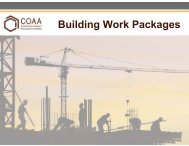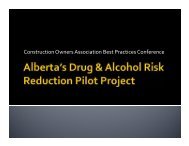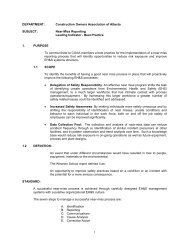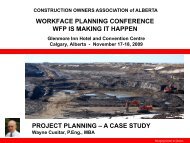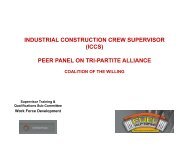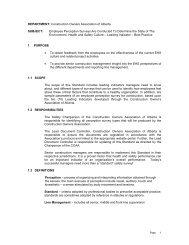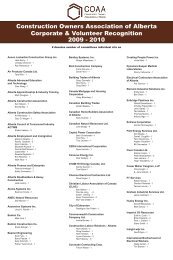Hazard Identification Analysis Prior to Start of a Project
Hazard Identification Analysis Prior to Start of a Project
Hazard Identification Analysis Prior to Start of a Project
Create successful ePaper yourself
Turn your PDF publications into a flip-book with our unique Google optimized e-Paper software.
DEPARTMENT:<br />
SUBJECT:<br />
Construction Owners Association <strong>of</strong> Alberta<br />
Implementation <strong>of</strong> a <strong>Hazard</strong> <strong>Identification</strong>/<strong>Analysis</strong> <strong>Prior</strong> <strong>to</strong> the <strong>Start</strong> <strong>of</strong><br />
a <strong>Project</strong> - Leading Indica<strong>to</strong>r - Best Practice<br />
1. PURPOSE<br />
To communicate <strong>to</strong> COAA members a best practice for the implementation <strong>of</strong> a <strong>Hazard</strong> <strong>Identification</strong><br />
/ <strong>Analysis</strong> process prior <strong>to</strong> the start <strong>of</strong> an industrial construction project.<br />
1.1 SCOPE<br />
Leading Indica<strong>to</strong>r<br />
The completion <strong>of</strong> a <strong>Hazard</strong> <strong>Identification</strong> / <strong>Analysis</strong> process prior <strong>to</strong> the start <strong>of</strong> a construction<br />
project on industrial construction sites is identified as one <strong>of</strong> the <strong>to</strong>p ten (10) Leading Indica<strong>to</strong>rs<br />
developed through the Construction Owner’s Association <strong>of</strong> Alberta.<br />
Leading indica<strong>to</strong>rs/activities are pro-active measurements associated with environmental, health and<br />
safety management system activities that are identifiable and are regarded as “best in class”<br />
performance measurements <strong>of</strong> construction environmental, health and safety management systems.<br />
Traditional EHS measured indica<strong>to</strong>rs are lagging indica<strong>to</strong>rs reflecting the past performance <strong>of</strong> a<br />
project. The COAA <strong>to</strong>p ten leading indica<strong>to</strong>rs are measurable activities that reflect positively on<br />
construction project EHS performance.<br />
Increase Knowledge <strong>of</strong> the <strong>Hazard</strong> <strong>Identification</strong> / <strong>Analysis</strong> process<br />
Each COAA member has its own hazard analysis techniques and risk matrix. It is not the intention <strong>of</strong><br />
this best practice <strong>to</strong> provide a specific, or a trademark hazard identification / analysis program. It is<br />
assumed that the hazard identification / analysis processes utilized by COAA members have the<br />
same general result <strong>of</strong> identifying and controlling hazards.<br />
In addition it is not the intention <strong>of</strong> this best practice <strong>to</strong> suggest a risk level matrix. Each COAA<br />
member needs <strong>to</strong> determine a risk matrix based on the member’s own acceptability <strong>of</strong> risk.<br />
The project <strong>Hazard</strong> <strong>Identification</strong> / <strong>Analysis</strong> processes continually evolves from the conception <strong>of</strong> the<br />
project and engineering phase, through construction, the commissioning <strong>of</strong> the unit, and the<br />
operating and maintaining <strong>of</strong> the unit.<br />
Owners tend <strong>to</strong> concentrate on operate maintain aspects <strong>of</strong> the hazard assessment process. These<br />
types <strong>of</strong> hazard identification / analysis processes include but are not limited <strong>to</strong>:<br />
• FEMA – Failure Modes and Effects <strong>Analysis</strong><br />
• LOPA – Layer <strong>of</strong> Protection <strong>Analysis</strong><br />
• PSM – Process Safety Management <strong>Analysis</strong><br />
• SIL – Safety Integrity Level <strong>Analysis</strong><br />
• HazOps – <strong>Hazard</strong> and Operability <strong>Analysis</strong><br />
• EIA – Environmental Impact Assessment<br />
Page 1 <strong>of</strong> 12
“Hands On” Contrac<strong>to</strong>rs concentrate on the construction aspects <strong>of</strong> the hazard assessment process.<br />
These types <strong>of</strong> hazard identification / <strong>Analysis</strong> processes include but are not limited <strong>to</strong>:<br />
• JHA – Job <strong>Hazard</strong> <strong>Analysis</strong> (task specific)<br />
• Permits – Operations specific task requirements<br />
• FLHA – Field Level <strong>Hazard</strong> <strong>Analysis</strong> – task assigned workers conducting a formalized task<br />
location assessment prior <strong>to</strong> starting work or after conditional change in the site<br />
environment.<br />
Typically, a disconnect exists between the owner hazard identification / analysis process and the<br />
contrac<strong>to</strong>r’s process. The intention <strong>of</strong> this best practice is <strong>to</strong> provide a <strong>to</strong>ol that compliments both<br />
processes <strong>to</strong> increase the performance <strong>of</strong> the hazard identification / analysis process <strong>to</strong> lower the<br />
likelihood <strong>of</strong> incidents occurring.<br />
<strong>Hazard</strong> <strong>Identification</strong> / <strong>Analysis</strong> Template<br />
This best practice includes a straw model <strong>Hazard</strong> <strong>Identification</strong> / analysis process that provides a<br />
generalized template <strong>to</strong> be implemented prior <strong>to</strong> the “pre-mobilization” phase <strong>of</strong> a project.<br />
<strong>Hazard</strong> identification / <strong>Analysis</strong> process<br />
The hazard assessment process spans the life span <strong>of</strong> the project from the project Scoping phase <strong>to</strong><br />
the completion and turnover <strong>of</strong> the project <strong>to</strong> the client. This best practice generates a flow chart <strong>to</strong><br />
provide a visual checklist, and <strong>to</strong> demonstrate the need <strong>to</strong> integrate the pre-award <strong>Hazard</strong><br />
<strong>Identification</strong> / <strong>Analysis</strong> process with other Environment, Health, and Safety (EHS) management<br />
systems (Site Specific EHS Plans), and typical <strong>Hazard</strong> <strong>Analysis</strong> systems (FEMA. LOPA, SIL, PSM,<br />
two week look ahead EHS integration assessments, JHA’s, HazOps, Permits, and Field Level<br />
<strong>Hazard</strong> Assessment). The flowchart models the utilization <strong>of</strong> the <strong>Hazard</strong> <strong>Identification</strong> / <strong>Analysis</strong><br />
Process with other EHS Management systems.<br />
Correlation between reducing incidents by utilizing leading indica<strong>to</strong>rs.<br />
The COAA best practices subcommittee has developed a list <strong>of</strong> 300 best practices that are<br />
considered leading indica<strong>to</strong>rs for the EHS performance <strong>of</strong> a project. The <strong>to</strong>p ten leading indica<strong>to</strong>rs<br />
have the greatest impact on reducing incidents. Ultimately, the intent <strong>of</strong> this best practice is <strong>to</strong><br />
provide a <strong>to</strong>ol that reduces incidents on industrial construction work sites. It is <strong>to</strong> be applied<br />
appropriately by all COAA members.<br />
1.2 Responsibilities<br />
COAA members are responsible for the implementation <strong>of</strong> this best practice within their project<br />
management systems. The development <strong>of</strong> hazard identification / analysis processes at each phase<br />
<strong>of</strong> design/construction from DBM through <strong>to</strong> pre-mobilization. If the COAA member retains the Prime<br />
Contrac<strong>to</strong>r responsibility then the COAA member is responsible <strong>to</strong> audit the hazard identification /<br />
analysis process for currency, accuracy, and integration during the projects life span.<br />
Engineering houses are responsible for the implementation <strong>of</strong> this Standard within their project<br />
management systems. The development and implementation <strong>of</strong> hazard identification / analysis<br />
processes at each phase <strong>of</strong> design from the Scoping study phase through DBM, and EDS phases.<br />
The “Prime Contrac<strong>to</strong>r” is responsible for the implementation <strong>of</strong> this Standard within their project<br />
management systems. The development and implementation <strong>of</strong> hazard identification / analysis<br />
processes at each phase <strong>of</strong> construction from the identification and acceptance <strong>of</strong> the “Prime<br />
Page 2 <strong>of</strong> 12
Contrac<strong>to</strong>r” role, through the contrac<strong>to</strong>r selection and pre-bid meetings, during the construction<br />
phase and concluding at the contract completion. The Prime Contrac<strong>to</strong>r is responsible <strong>to</strong> audit the<br />
“hands on” contrac<strong>to</strong>r and their hazard identification / analysis process for currency, accuracy, and<br />
integration during the projects life span.<br />
“Hands On” contrac<strong>to</strong>rs are responsible for the implementation <strong>of</strong> this Best practice within their<br />
project management systems, and the development and implementation <strong>of</strong> hazard identification /<br />
analysis processes at each phase <strong>of</strong> construction from the pre-bid meeting through <strong>to</strong> turn-over <strong>to</strong><br />
the client.<br />
1.3 Definitions<br />
DBM<br />
Design Basis Memorandum<br />
EDS<br />
Engineering Design Specification<br />
<strong>Hazard</strong> <strong>Identification</strong> / <strong>Analysis</strong><br />
The objective <strong>of</strong> any hazard identification / <strong>Analysis</strong> process is <strong>to</strong> introduce hazard identification and<br />
controls early in the project by identifying risks associated with the project.<br />
<strong>Hazard</strong> Assessment<br />
A formal process used <strong>to</strong> identify hazards that may create losses <strong>to</strong> people, equipment, materials,<br />
property or the environment.<br />
HAZOP<br />
A <strong>Hazard</strong> and Operability (HAZOP) study is a structured process which is intended <strong>to</strong> identify all<br />
possible deviations from the way a design is intended <strong>to</strong> work and all <strong>of</strong> the hazards or operational<br />
difficulties associated with those deviations.<br />
Job <strong>Hazard</strong> <strong>Analysis</strong> (JHA)<br />
During the hazard assessment process certain tasks will be identified that present additional risk.<br />
These tasks will require additional review and assessment and a specific safe work procedure<br />
developed for the task.<br />
Procedures<br />
Procedures refer <strong>to</strong> step-by-step task descriptions associated with project.<br />
Risk<br />
Probability that during a period <strong>of</strong> activity a hazard will result in an incident with definable<br />
consequence<br />
Risk Management<br />
Page 3 <strong>of</strong> 12
Reduction <strong>of</strong> the consequence and probability <strong>of</strong> risk or risks <strong>to</strong> an acceptable level <strong>to</strong> ensure a zero<br />
injury workforce<br />
2. BEST PRACTICE<br />
A majority <strong>of</strong> the hazards associated with a project can be and are identified early in the design and<br />
development phase through the use <strong>of</strong> formalized hazard analysis techniques.<br />
Typically, the engineering and the owner representatives will conduct a macro hazard identification /<br />
analysis and correct and control identified hazards in the design and engineering phases <strong>of</strong> the<br />
project. This is prior <strong>to</strong> the “hands on” contrac<strong>to</strong>r selection phase.<br />
It is recommended that the result <strong>of</strong> the hazard identification / analysis process are incorporated at<br />
the various design reviews, and contrac<strong>to</strong>r assessment meetings (DBM, EDS, pre-bid meeting,<br />
contract award meeting, and pre-mobilization meeting- see hazard identification / <strong>Analysis</strong> process<br />
flow chart). A copy <strong>of</strong> all hazard identification / analysis (“macro analysis”) must be part <strong>of</strong> the<br />
owner’s deliverables, at the pre-bid meeting, <strong>to</strong> the “hands on” contrac<strong>to</strong>rs bidding the work.<br />
<strong>Hazard</strong> identification, analysis, and reporting do not terminate at the pre-bid meeting. The hazard<br />
identification / analysis process, like the entire EHS process must be an on-going active “evergreen”<br />
process if it is <strong>to</strong> affect the EHS performance <strong>of</strong> the project.<br />
The macro analysis provided <strong>to</strong> the “hands on” contrac<strong>to</strong>rs should be a summary <strong>of</strong> all <strong>of</strong> the hazard<br />
identification / analysis completed prior <strong>to</strong> the “pre-bid” meeting. It should provide a background <strong>to</strong><br />
the contrac<strong>to</strong>r on the scope <strong>of</strong> the project, and the limitations <strong>of</strong> the assessment (see Appendix 1A.).<br />
The analysis should then describe in general the hazards associated with the location <strong>of</strong> the project<br />
(see Appendix 1A.).<br />
Health and hygiene hazards need <strong>to</strong> be considered, based on the scope <strong>of</strong> the project, and current<br />
controls for these hazards are <strong>to</strong> be outlined with any suggested controls for the length <strong>of</strong> the project.<br />
Applicable owner, or prime contrac<strong>to</strong>r procedures, practices, standards, and policies should be<br />
referenced for the contrac<strong>to</strong>r’s use (see Appendix 1A.).<br />
Safety hazards need <strong>to</strong> be considered, based on the scope <strong>of</strong> the project, and current controls for<br />
these hazards need <strong>to</strong> be outlined with suggested controls for the length <strong>of</strong> the project. A comparison<br />
<strong>of</strong> the possible tasks during the project <strong>to</strong> the legislated Occupational Health and Safety<br />
requirements is suggested. Applicable owner, or prime contrac<strong>to</strong>r procedures, practices, standards,<br />
and policies should be referenced for the contrac<strong>to</strong>r’s use (see Appendix 1A.).<br />
Environmental hazards need <strong>to</strong> be considered, based on the scope <strong>of</strong> the project, and current<br />
controls for these hazards need <strong>to</strong> be outlined with suggested controls for the length <strong>of</strong> the project. A<br />
comparison <strong>of</strong> the possible tasks during the project <strong>to</strong> the owner or site environmental requirements<br />
is suggested. Applicable owner, or prime contrac<strong>to</strong>r procedures, practices, standards, and policies<br />
should be referenced for the contrac<strong>to</strong>r’s use (see Appendix 1A.).<br />
Security concerns need <strong>to</strong> be considered, based on the scope <strong>of</strong> the project, and current controls for<br />
these hazards need <strong>to</strong> be outlined with suggested controls for the length <strong>of</strong> the project. A comparison<br />
<strong>of</strong> the possible concerns during the project <strong>to</strong> the owner or site security requirements is suggested.<br />
Applicable owner, or prime contrac<strong>to</strong>r procedures, practices, standards, and policies should be<br />
referenced for the contrac<strong>to</strong>r’s use (see Appendix 1A.).<br />
After delivery <strong>of</strong> the macro analysis <strong>to</strong> the contrac<strong>to</strong>r; the contrac<strong>to</strong>r is then expected <strong>to</strong> take the<br />
owner’s macro analysis and make it contract specific. The contrac<strong>to</strong>r will integrate this macro<br />
Page 4 <strong>of</strong> 12
analysis, and develop their site specific EHS plan based on their micro (task specific) hazard id /<br />
analysis.<br />
The contrac<strong>to</strong>r’s EHS plan should be submitted <strong>to</strong> the owner, or Prime Contrac<strong>to</strong>r, at the contract<br />
submission stage for review as part <strong>of</strong> their contract submission. COAA members should<br />
incorporate this in<strong>to</strong> their contract requirements, and review the submission for completeness and<br />
project competency. This then becomes a due diligence document for the owner and prime<br />
contrac<strong>to</strong>r.<br />
Through the life <strong>of</strong> the program, the hazard identification / analysis must constantly be reviewed for<br />
currency and accuracy. It is an “evergreen” document that is the basis for the integration <strong>of</strong> EHS<br />
systems in the project scheduling and planning process. It is then the responsibility <strong>of</strong> the owner, or<br />
prime contrac<strong>to</strong>r, <strong>to</strong> audit the hazard identification / analysis process for currency, accuracy, and<br />
integration during the projects life span.<br />
3. IMPLEMENTATION<br />
Implementation by COAA members requires integration <strong>of</strong> this best practice in COAA member’s<br />
Engineering and Design, Contrac<strong>to</strong>r Management, and <strong>Hazard</strong> <strong>Analysis</strong> standards, practices and<br />
procedures.<br />
Engineering and Design<br />
In the engineering and design phase; hazard assessments, <strong>of</strong> any type need <strong>to</strong> be conducted with<br />
the results documented and carried forward <strong>to</strong> the next stage <strong>of</strong> design <strong>to</strong> ensure consistency in the<br />
development <strong>of</strong> the hazard assessment and control process through out the life <strong>of</strong> the project. These<br />
assessments (including environmental impact assessments) are the foundation <strong>of</strong> the macro<br />
assessment.<br />
Contrac<strong>to</strong>r Management<br />
The contrac<strong>to</strong>r management phase requires the creation <strong>of</strong> a macro assessment – <strong>Hazard</strong><br />
<strong>Identification</strong> / <strong>Analysis</strong> Process – <strong>to</strong> be in place prior <strong>to</strong> the start <strong>of</strong> the project.<br />
To ensure that this measurement is met for all industrial projects it is necessary for COAA members<br />
<strong>to</strong> review their contrac<strong>to</strong>r management program from the qualification and pre-bid phase through <strong>to</strong><br />
commissioning and turnover <strong>of</strong> the project. Resources are required <strong>to</strong> complete the Owner’s portion<br />
<strong>of</strong> the hazard identification / analysis process as well the evaluation <strong>of</strong> the contrac<strong>to</strong>r’s EHS plan<br />
based on the hazard identification / analysis and the contract specific task analysis. In addition<br />
resources are necessary for the auditing function <strong>to</strong> ensure that the hazard identification process<br />
utilized by the contrac<strong>to</strong>r is current and accurate.<br />
<strong>Hazard</strong> <strong>Identification</strong> <strong>Analysis</strong><br />
<strong>Hazard</strong> analysis requires COAA members <strong>to</strong> implement a hazard identification <strong>to</strong>ol that meets the<br />
general template provided, and <strong>to</strong> ensure competent individuals facilitate this process.<br />
Implementation<br />
Leadership within each COAA member is responsible <strong>to</strong> carry out the implementation <strong>of</strong> this and<br />
other COAA endorsed best practices within the framework <strong>of</strong> their organizations.<br />
4. INTERPRETATION AND UPDATING<br />
Page 5 <strong>of</strong> 12
The Safety Chairperson <strong>of</strong> the Construction Owners Association <strong>of</strong> Alberta, Safety Committee shall<br />
ensure interpretation and updating <strong>of</strong> this best practice.<br />
5. APPROVED BY ______________________________<br />
Peter Dunfield<br />
Safety Chairperson<br />
Construction Safety Association <strong>of</strong> Alberta (COAA)<br />
Page 6 <strong>of</strong> 12
Attachment 1A.<br />
Known and Potential<br />
Health, Safety, Environment and Security<br />
Pre-Bid <strong>Hazard</strong> <strong>Identification</strong> / <strong>Analysis</strong><br />
Contract Number: ______________________<br />
<strong>Project</strong> Name: _____________________<br />
Location: __________________________<br />
Background:<br />
• Describe the scope <strong>of</strong> the project.<br />
• Establish the limitations <strong>of</strong> the analysis.<br />
• Establish which hazard assessments have been completed <strong>to</strong> date and attach these<br />
assessments (provided there are not intellectual property issues) <strong>to</strong> the appendix.<br />
Location:<br />
• Define the specific location <strong>of</strong> the project.<br />
• Include any hazards directly the result <strong>of</strong> location (examples may include):<br />
• traffic hazards, and access <strong>to</strong> the site<br />
• congestion due <strong>to</strong> the plot plan,<br />
• environmental considerations due <strong>to</strong> water run<strong>of</strong>f<br />
• weather<br />
• process considerations<br />
• known or unknown underground utilities<br />
• soil compaction with regards <strong>to</strong> trenching/excavations<br />
• emergency response concerns<br />
• Include suggested controls for the identified hazards<br />
• Include a reference <strong>to</strong> any studies or hazard assessments that assessed the location previous <strong>to</strong><br />
this document (add documents <strong>to</strong> the Appendix).<br />
Health:<br />
• Define the specific health, and hygiene issues related <strong>to</strong> the project or site.<br />
• Include any health, and hygiene hazards directly the result <strong>of</strong> project (examples may include):<br />
• A list <strong>of</strong> possible chemical and biological exposures (MSDS requirement) as a result <strong>of</strong> the<br />
location <strong>of</strong> the project, or the materials <strong>to</strong> be used in the construction phase (generally).<br />
• Determination <strong>of</strong> substances and processes requiring a code <strong>of</strong> practice<br />
• Occupational exposure limits for possible chemical or biological substances<br />
• Noise exposure (add documents <strong>to</strong> the Appendix).<br />
• Current, and past industrial hygiene studies, and determination <strong>of</strong> adequacy <strong>of</strong> the in-place<br />
program for the project (add documents <strong>to</strong> the Appendix).<br />
Page 7 <strong>of</strong> 12
• Suggestions for improvement <strong>of</strong> the moni<strong>to</strong>ring <strong>of</strong> exposures over the life <strong>of</strong> the project<br />
• Occupational Health Service needs based on the expected manpower requirements (include<br />
a construction manpower chart over the life <strong>of</strong> the project), and the regula<strong>to</strong>ry requirements.<br />
• Include suggested controls for the health, and hygiene hazards<br />
• Include a reference <strong>to</strong> any studies or health/hazard assessments that determined the possible<br />
health hazards prior <strong>to</strong> this document (add documents <strong>to</strong> the Appendix).<br />
• Include a reference <strong>to</strong> related owner, or prime contrac<strong>to</strong>r procedures, practices, standards, or<br />
policies.<br />
Safety:<br />
• Define the specific safety issues related <strong>to</strong> the project or site.<br />
• Include any safety hazards directly the result <strong>of</strong> the project (examples may include):<br />
• Excavations/trenching<br />
• Working at elevations<br />
• Engineered, critical lifts<br />
• Hot Work<br />
• Confined Space<br />
• Lockouts<br />
• Tie-ins, hot taps<br />
• Personal Protective Equipment requirements<br />
• Permitting<br />
Include a determination <strong>of</strong> the applicability <strong>of</strong> the Alberta Legislated <strong>Hazard</strong> Assessment requirements<br />
versus the scope <strong>of</strong> the project<br />
• 52(1) Confined spaces<br />
• 165(1) Explosive atmosphere<br />
• 210 Manual lifting<br />
• 221(1) Noise<br />
• 228(1) PPE<br />
• 233(2) Footwear<br />
• 241(1) Life jackets<br />
• 242 Limb/body protection<br />
• 244(1) RPE (airborne contaminants)<br />
• 270(3) ROPS<br />
• 272(1) FOPS<br />
• 291 Radiation<br />
• 310(2) Machine guards<br />
• 317 Machine failure<br />
• 319 Cutting machines<br />
• 362 Machine contact<br />
• 389 Violence<br />
• 393 Working alone<br />
• Include a determination <strong>of</strong> the applicability <strong>of</strong> the Alberta Legislated Safety related code <strong>of</strong><br />
practice requirements versus the scope <strong>of</strong> the project.<br />
• Confined Space<br />
• Respira<strong>to</strong>ry Protective Equipment<br />
• Fall Protection Plan<br />
• Emergency Response<br />
Page 8 <strong>of</strong> 12
• Include suggested controls for these safety hazards<br />
• Include a reference <strong>to</strong> any studies safety hazard assessments that assessed the possible safety<br />
hazards prior <strong>to</strong> this document (add documents <strong>to</strong> the Appendix).<br />
• Include a reference <strong>to</strong> related owner, or prime contrac<strong>to</strong>r procedures, practices, standards, or<br />
policies.<br />
Environment:<br />
• Define the specific environmental issues related <strong>to</strong> the project or site.<br />
• Include any environmental hazards directly the result <strong>of</strong> the project (examples may include):<br />
• Soil contamination<br />
• Air quality plan<br />
• Process upsets as a result <strong>of</strong> a construction incident<br />
• Waste handling<br />
• <strong>Hazard</strong>ous waste<br />
• Recycle plan<br />
• Water management plan<br />
• Spill control<br />
• Emissions control<br />
• Discovery <strong>of</strong> unexpected conditions<br />
• Controlled products plan (Workplace <strong>Hazard</strong>ous Information Management System)<br />
• Include a determination <strong>of</strong> the applicability <strong>of</strong> the Alberta Legislated Environmental requirements<br />
versus the scope <strong>of</strong> the project (examples may include):<br />
• Alberta Environmental Protection and Enhancement Act<br />
• Operating Approvals (Limits <strong>of</strong> release)<br />
• Transportation <strong>of</strong> Dangerous Goods<br />
• Alberta Energy and Utilities Board Guide 55: S<strong>to</strong>rage Requirements for the Upstream<br />
Petroleum Industry<br />
• Alberta Fire Code – <strong>Hazard</strong>ous Waste S<strong>to</strong>rage Guidelines<br />
• Include suggested controls for these environmental hazards<br />
• Include a reference <strong>to</strong> any studies or environmental impact assessments that determined the<br />
possible impact <strong>of</strong> the project prior <strong>to</strong> this document (add documents <strong>to</strong> the Appendix).<br />
• Include a reference <strong>to</strong> related owner, or prime contrac<strong>to</strong>r procedures, practices, standards, or<br />
policies.<br />
Security:<br />
• Define the specific security issues related <strong>to</strong> the project or site.<br />
• Include any security concerns directly the result <strong>of</strong> the project (examples may include):<br />
• Travel and site access<br />
• Defined site boundaries<br />
• <strong>Identification</strong> badges<br />
• Vehicle permits<br />
• Pre-Access Drug and Alcohol Testing<br />
• Include suggested controls for these security concerns<br />
• Include a reference <strong>to</strong> any studies or security assessments that determined the possible security<br />
implications <strong>of</strong> the project prior <strong>to</strong> this document (add documents <strong>to</strong> the Appendix).<br />
Page 9 <strong>of</strong> 12
• Include a reference <strong>to</strong> related owner, or prime contrac<strong>to</strong>r procedures, practices, standards, or<br />
policies.<br />
Appendix:<br />
• Any document referenced in the <strong>Hazard</strong> <strong>Identification</strong> / <strong>Analysis</strong><br />
Page 10 <strong>of</strong> 12
<strong>Hazard</strong> <strong>Identification</strong> / <strong>Analysis</strong> Process Flow Chart<br />
Design and Engineering Phase Contrac<strong>to</strong>r Selection Phase “Hands On” Work<br />
<strong>Project</strong> <strong>Identification</strong> and<br />
scoping phase<br />
Contrac<strong>to</strong>r Selection<br />
Contrac<strong>to</strong>r selection<br />
Development <strong>of</strong> Haz Id /<br />
<strong>Analysis</strong> task Specific<br />
COAA EHS Pre-Qualification<br />
Best Practice<br />
Initial <strong>Hazard</strong> Review <strong>to</strong>ols<br />
Pre-mobilization Meeting<br />
<strong>Project</strong> DBM phase<br />
COAA <strong>Hazard</strong> Id / <strong>Analysis</strong><br />
Best Practice<br />
Pre-Bid Meeting<br />
Implementa<strong>to</strong>n in<strong>to</strong><br />
Scheduling and Planning<br />
processes<br />
Attachment 1B.<br />
<strong>Hazard</strong> <strong>Identification</strong> / <strong>Analysis</strong><br />
Inherent Safety <strong>Analysis</strong><br />
<strong>Hazard</strong> <strong>Identification</strong> / <strong>Analysis</strong><br />
Tools<br />
<strong>Project</strong> EDS phase<br />
NO<br />
Tender submission with Conrac<strong>to</strong>r<br />
EHS (Plan) <strong>Hazard</strong> Identication /<br />
<strong>Analysis</strong> included in the tendered<br />
documents.<br />
Contrac<strong>to</strong>r EHS Plan with macro<br />
<strong>Hazard</strong> Id incorporated & reviewed<br />
Conducting the work<br />
Using JHA’s, HazOps,<br />
Permits, Field Level <strong>Hazard</strong><br />
Assessment Process<br />
Review <strong>of</strong> <strong>Hazard</strong><br />
<strong>Identification</strong> / <strong>Analysis</strong><br />
YES<br />
<strong>Hazard</strong> <strong>Identification</strong> / <strong>Analysis</strong><br />
Inherent Safety <strong>Analysis</strong><br />
HazOps, FEMA, LOPA, PSM, SIL, EIA<br />
Contrac<strong>to</strong>r not<br />
selected<br />
EH&S Qualified<br />
Page 11 <strong>of</strong> 12
COAA Vision for Safety<br />
“No one gets hurt in heavy industrial<br />
construction”<br />
Safety Committee Mandate:<br />
Work collaboratively <strong>to</strong> improve overall<br />
safety culture and performance in the<br />
construction industry -<br />
identify/develop/support Best Practices<br />
Page 12 <strong>of</strong> 12






